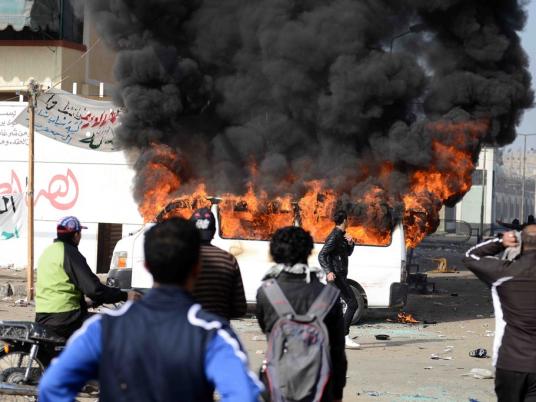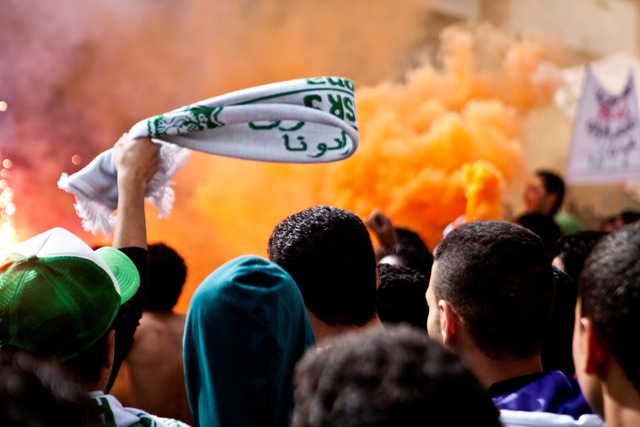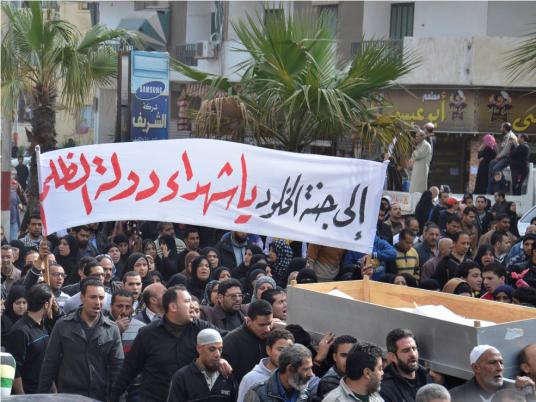On his way home, Mohamed Yousri was shot dead after clashes erupted between Interior Ministry forces and crowds who gathered outside El Arab Police station in Port Said on 26 January. Earlier that day, 21 defendants from the city were sentenced to death for involvement in the killing of 74 football spectators at a match last year. In the two days that followed the verdict, more than 40 people were killed.
“My relative, Mohamed Yousri, was going to his house, next to the police station. They shot him in the head,” Hassan Aboul Nasr said as he sat on a bench outside a hospital morgue on the night of 27 January.
Aboul Nasr, among other victims’ relatives and neighborhood residents who had gathered at El-Amiri hospital, expressed a sense of disillusionment with, distrust of, and rage against the state’s agents and representatives: The police, the judiciary, and the president.
In many instances, the Egyptian state only exist to the residents of Port Said, as to others across the country, only through its coercive apparatus, most notably the police, while failing to guarantee their rights.
Yet ironically, state officials have recently crescendoed talk on “haybat al-dawl" (state prestige), lamented the "inheyar al-dawla" (breakdown of the state), and insisted on throwing the blame on unidentified parties, thus attempting to absolve “their” state of any responsibility towards its subjects.
Despite all talk on the supposed grandeur of the state and its role as the regulator of society, the Egyptian state is constantly failing to protect its subjects from “random” gunfire. Over the past two, it has repeatedly denied responsibility for the use of force and claimed the existence of a “third party.” Whether such claims are true is irrelevant, because it is particularly in these situations that the people believe that they are targeted by the state, such as in the case of Port Said.
“They are killing us, our dirty government is killing us,” shouted one man as bleeding youths and elderly men on stretches were being ferried in and out of the emergency room. A sense of disbelief pervaded the hospital corridors. Men displayed marks of shots on their bodies. It wasn’t clear whether these were bird shots or live rounds. Female relatives of the deceased and injured were screaming on the top of their voices: “What did we do? What is all this for?” An old man said: “These are not thugs fighting each other … all those who died are respectable youth.”
Not all of the wounded or the deceased were the so-called protesters or the so-called rioters. Many of them were going about their daily lives as usual and were not in a situation of confrontation with the state.
“When we were on our way [to the cemetery to bury Mohamed Yousri], they [the police] kept shooting at us until we had to turn back,” Aboul Nasr said, describing the funeral procession of his relative. “[While we were marching], the [armored] vehicles kept passing by, shooting at people. They threw tear gas canisters and people ran away.” Other men in the hospital corridors and in front of its entrance cried: “He [Morsi] should remove his government [representatives] from Port Said” and “let him withdraw his police.”
The Port Said residents who gathered at the hospital expressed a feeling of being a “scapegoat” for the state’s failure to bring to justice the people who they saw as the “real” perpetrators. They were convinced that the verdict against the defendants was unjust and “politicized” in order to appease others, mainly the Ahli Club fans, who “supported Morsy,” as one resident put it.
“The person who killed Sadat was not sentenced to death, how come these were sentenced to death?” shouted one man, while another woman retorted: “Did the people who were involved in the Battle of the Camel get sentenced to death?”
So, even the judicial authority, which has been flaunted by the media as being held in great esteem by the Egyptians, was being derided by the people at the hospital.
What happened in Port Said could not be explained as “acts of sabotage” committed by “outlaws” and “criminals” against whom the use of violence by state agents was justified. The events of Port Said were another instance of the state yet again contributing to turning a protest situation – an expression of rage; whether or not it was justified is besides the point – into a situation of escalating violence committed by its agents. Whether the members of the crowd provoked the security forces by initiating the throwing of rocks and Molotov cocktails does not justify the Interior Ministry’s use of violence, since in this situation the two “violences” are not equal.
The state that has monopoly over the legitimate use of violence, through its police and armed forces, is blaming its very victims for using “violence.” Yet its own violence is reaching a larger segment of the people, who were not initially involved in any acts of protest or confrontation with state agents, such as thirty-year-old Ahmed Mokhtar, who was shot in the leg by Interior Ministry soldiers on coming out of the mosque after performing the night prayer.
In so doing, the state is unintentionally helping give rise to more intense sentiments of rage among wider strata of the population. Mohamed El-Sayyed, aged 27, received a birdshot to the tip of his ear as he was observing the scene in front of the police station. He said: “Someone like me will not go home until I get my right back.”
Ola Galal is a Cairo-based freelance journalist and a graduate student of anthropology.



